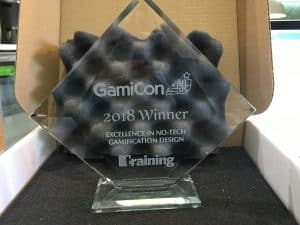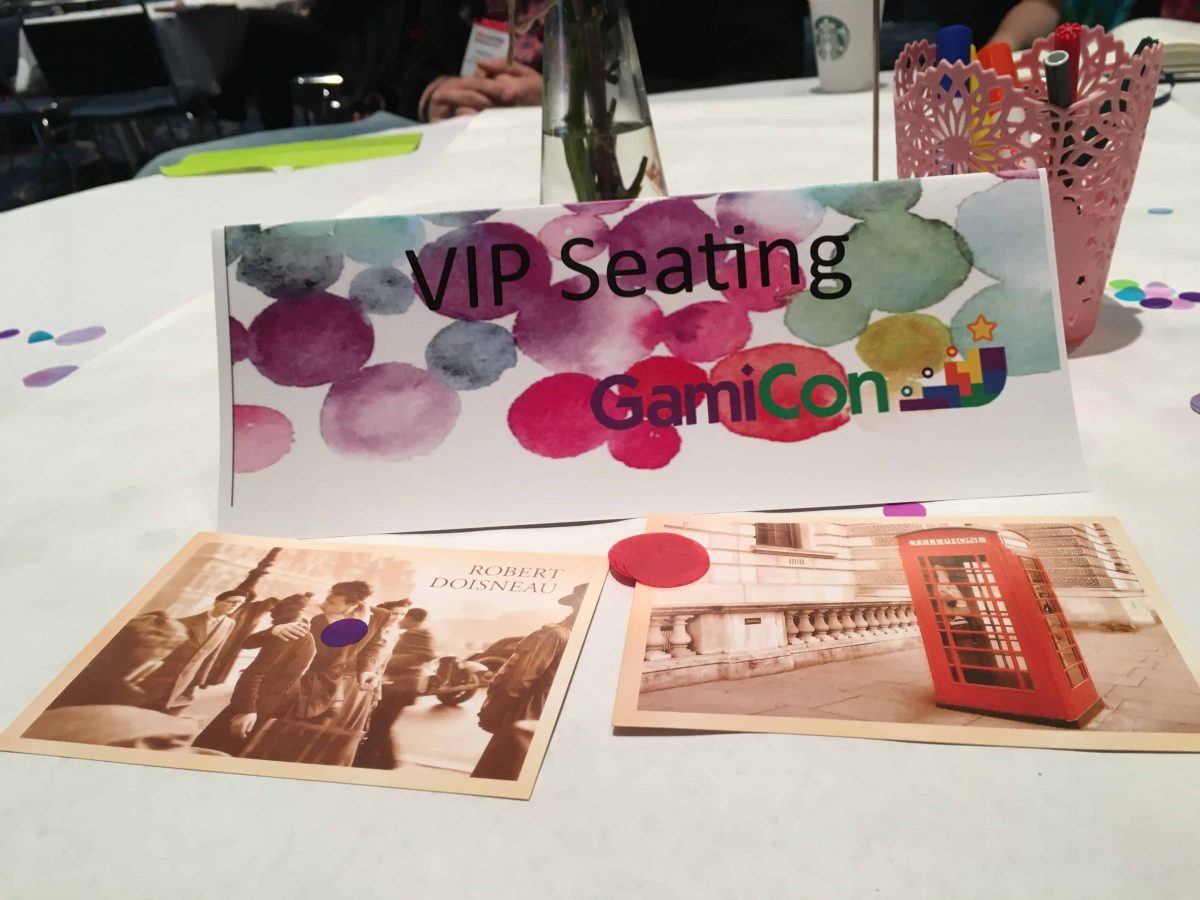If you have been following my social media, then you know I was at GamiCon 2018 in Chicago, USA, a co-located event with Online Learning Conference from Training Magazine. My good friends Monica Cornetti and Jonathan Peters from Sententia Gamification and their team made the decision to organise this inaugural event to put together the first learning focused gamification conference in North America.
My journey started off literally with a bang, just after I arrived a massive thunder and lightning spectacle appeared, which unfortunately played havoc with a few people’s schedules. Thankfully it only lasted a few hours. The next day, we managed to explore a bit of the city and walk a small part of the Chicago Marathon trail, which was also due to take place that weekend.
GamiCon started with an escape room designed by Michiel Van Eunen with my team definitely not quite breaking out and none of the teams making it out in the allocated time. One group eventually managed to break through all the clues and release all of us. I think escape rooms are useful when you have a need for people to work together on problems that are maybe not so straightforward. We had fun and a good team dynamic.
On day 1 of GamiCon, the stand-out moments for me were the Amazon Alexa English accent training. Considering speaking assistant from Apple Siri (and probably Alexa) don’t understand me half of the time and give ridiculous suggestions, I thought this was a really useful way of training their people, who had to do transcription of voices. The other project that grabbed my attention was “You can’t gamify that” from Brown University, which took us through the journey of gamifying an academic humanities course into a multi-level quest with a fun storyline. It was well deserved that they won the best narrative and best overall project in the awards.
Project Throwdown
The project throwdown aka 3-minute pitches about our projects for the coveted gamification awards took me a bit by sudden surprise because all of a sudden lunch was replaced with giving a pitch. I must say all entries gave me great encouragement that those of us who have been evangelising about how to carry out gamification design for learning is having a positive impact and at least in this community is giving great results.
My personal favourite was the project for military service people learning on how to remain in a financially positive situation so they don’t have to leave the service. In a way, I saw it as a fabulous example of how gamification can make a difference. The learning included branching scenarios, instant feedback and people could test their decision-making practices in a safe online setting. The real epic meaning will come when this is rolled out for not just the military but also the general public in the USA.
After the official three minute pitch, we had more time to share our projects and answer questions for the judges. The judges apparently had a difficult task deciding on the winners, they had to meet three times to come to a conclusion.
Gamified event
Ambassador Adventure had people travel around various roundtables to listen to 10 minutes of wise advice or demos from people like my good self. I used my gamification design card deck to explain how I approach gamification in the corporate sector often with people who don’t play games. Participants travelled in teams and also experienced some augmented reality to guide them around the room as well as unravelling a word puzzle.
The main event app was a big hit, thanks to Bernardo Leytaf from Blue Rabbit. People were actively collecting login codes at the end of speeches, answering questions and sharing socially to gain coins for spending in the store on the app. Different levels gave different options for things like T-shirts, books, gamification card decks, courses, etc. Definitely worth looking into when you have events.
At every point, there were opportunities to experience gamification. I think it is the very first time a gamification conference was completely gamified with a variety of challenges, adventures, geo-tagging quest, escape rooms and much more.
Day 2
On day two Jonathan Peters took us through evolutionary psychology and the modern learner. He made great connections in how in history games have been part of our way of sharing information and how in some ways this was lost and now making a return. Motivation having more impact on how learners absorb information and in what way it is most effective for the individual.
He set up me up fantastically well to share my revised learning gamification framework, which I designed out of frustration of what I was seeing from learning technology organisations 5 years ago and for a majority unfortunately still today too. Although there are improvements happening. I am always surprised that in a learning audience, people have yet to come across ClassCraft, which in my view is one of the coolest learning platforms and great examples of gamification for long haul learning.
For those of you already familiar with my earlier version of the learning gamification framework I have added a few elements, namely why does your learner learn and what level of proof does the learner want to achieve. Between these two point we create gamified learning experiences. You can see my presentation on the slideshare link below.
Then Ahmed Hossan took us through his way of creating a blended gamification approach for increasing diversity and ways of how online and face to face learning could work well together. People collected physical badges, which looked a little like mini-awards, which you could keep on your desk. Dr Phillip Bush, then shared his experience of designing in two locations Yemen and Germany, and how they went about encouraging inclusion on both sides with a view of creating serious games for positive impact. I personally would love to see more projects for the greater good of humanity and encouraging peace, inclusion, understanding. Our world sure could do with these intentions.
Design sprints and workshops
Both on day 1 and day 2 we had the opportunity to try out design workshops and deeper dives into gamification from a variety of angles. Having observed a few of the groups, I have to say that our approaches the world over are very similar. I did my first ever workshop style gamification design workshop in Paris at the Gamification of HR summit in 2014 and I have seen various similar versions since. I guess the fact that design thinking and game card decks work well together. Marigo Raftoupolous levelled up our design workshops with an agile sprint approach and empathy mapping thrown in. I really enjoyed trying to solve our tricky problem and although our team had a slow start, we got there in the end.
The conference closed and merged with the opening of the Online Learning Conference with the training test kitchen and the awards for project throwdown.
The winners of the GamiCon 18 awards were as follows:
Best Overall project: “You can’t gamify that” – Brown University
Best narrative: Virtual simulations for therapists – Ryerson university
Excellence in eLearning or Web-Based Gamification Design: “Misadventures in Money Management” – Mechel Glass ( for defence forces in USA)
Best use of Surprise and Delight: ” You can’t gamify that” – Brown university
Excellence in no-tech gamification design: Hacksagon! Cyber Security board game for Chubb Insurance designed by Gamification Nation

We are for sure thrilled to have earned the no-tech award and our client is equally delighted. I also felt the competition was of great standard and I understand why the judges had so much trouble deciding on winners. It was great to see that we had not one single point-badges-leaderboard entry! This is telling of where our industry is heading and I consider it a fantastically positive sign.
With the jetlag wearing off a little, I feel grateful to have met so many fabulous people with shared interests. I guess if we could influence more and more of the wider learning community, over time what we saw in the award applications will become a new standard and drag all the reluctant hangers on to PBL lazy gamification into learning related gamification 3.0. I really feel we are moving in the right direction, let’s hope Europe can follow this lead.



